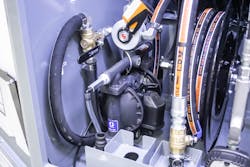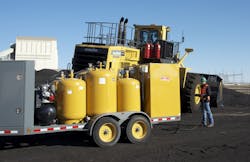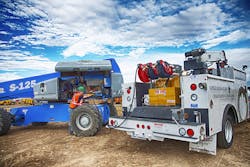Evacuation Systems Keep Oil in Its Place
There are several options for evacuating oils and other fluids during preventive maintenance, and before making a choice, maintenance managers should consider their location and available power source, as well as protecting machine systems from contamination.
Fluids are the lifeblood of a machine, and with today’s Tier 4-F engines having strict tolerances for clean oil, the evacuation/filling procedure becomes more important than ever.
The choices include mechanically driven pump systems, vacuum-based pump systems, and the old-fashioned procedure of letting the oil drain into a pan before adding new oil.
“You have to have some type of system, some energized system to pull [the fluids] out of the machine compartment,” says Mike Brennan, CEM, co-owner of CDMB Consulting, Bradenton, Florida, and formerly the fleet manager for Manatee County, Florida.
“Otherwise, you’re going to drop the plug and drain the oil out, and you’ll be there all day,” Brennan says. “Yes, it’s the way you did it back in the day, but with technology today, oil-evacuation systems, you really need to be using them.”
Multiple benefits
Brennan cites time savings, protecting the environment, and contamination as some of the reasons to employ a system.
“Any time that you can keep used oil in an enclosed system [draining] from one component, an engine or whatever, you’re miles ahead,” he says. “Because when you have a spill, you’ve got to stop and clean up that spill; if it’s big enough, you have to report it—and look at all that wasted time.
“If you can just plug in and evacuate the oil from here to there, and it never sees any air and it never comes out of an enclosed system, you can make the PM happen and go on and do something else,” Brennan says.
As fleet manager for Manatee County, Brennan used air-pressure operated diaphragm (vacuum) pumps.
“They were very efficient and worked very well,” he says. “We had mechanical transfer pumps that we used on a limited, individual basis. Say we were in the field and we had to pull a compartment down, we would take a mechanical pump and use that. Anywhere in the shops, we had vacuum systems.”
The choice between vacuum and mechanical also depends on the power that’s available and convenient. The shop and the field can be two different animals.
“It depends on what your energy source is. You can have electric, they’re all going to work similarly, depending on how you hook them up to the machine and what the access is,” Brennan says.
“In a shop facility, you’re going to have air pressure right there all the time anyway. To me, the air pressure is the way to go, plug into an air hose with a system and have a waste oil container right there, and pump it right into it,” he says. “Anytime you use vacuum and air pressure you’re better off.”
Efficient, clean oil-evacuation systems also mesh well with today’s workforce.
“One of the big things that I see with oil-evac systems is the benefit to the technician,” Brennan says. “Technicians these days, and the newer upcoming technicians, are not really into getting that oily and dirty, not to mention crawling around and having oil drip on them. So they’re very favorable to keeping that
oil contained.”
In addition, keeping the process clean means the technician can move on to other tasks more quickly; they do not have to stop to wash up.
“And you don’t have all of those oil-drain pans taking up space,” Brennan says. “They have a tendency to get oily, greasy, and nasty. You still have to have a few for certain things, but you eliminate a lot of that bulky equipment hanging around.”
A number of manufacturers make dedicated oil-evacuation systems, including Sage Oil Vac (pictured here), Lincoln, RPM, and Graco.
Choosing a system
“From skids, trailers, and trucks to tank sizes and pumping methods, there are several factors you should consider before adding a mobile lube [and oil-evacuation] system,” says Aaron Sage, CEO of Sage Oil Vac, Amarillo, Texas.
Sage says the majority of lube equipment manufacturers use mechanical pumps. These sometimes require maintenance and repair. Pumps may fail and need to be replaced or rebuilt. “And since each tank on a mobile lube system has a diaphragm and mechanical pump, maintenance and repair needs for these systems can be time-consuming and costly,” Sage says.
Vacuum technology, which uses compressed air to push oil out of the tank, does not require a pump.
“To fill the tanks or to suction used oil up, you simply need to reverse the process to create a vacuum within the tank,” Sage says. “When the valve is opened, suction is created as the tank equalizes. It’s a much faster process than what you’ll get with a mechanical pump.”
Since there are no moving parts inside the tanks, vacuum systems are completely sealed. Mechanical pump systems require air breathers so that tanks can vent, which can lead to contamination over time, according to Sage.
“Mobile lube equipment tank size can range from 10 gallons all the way up 250 gallons and will typically include two to eight different tanks,” Sage says. “The size and number of the tanks you need is dependent on the size of the equipment in your fleet and what you intend to do with your mobile lube system.
“If your company primarily operates compact equipment, like skid steer loaders and compact excavators, that are being frequently trailered from job to job, you may want to invest in a small lube cart that can be easily wheeled around the shop,” Sage says. “Using a small lube system will help speed up oil changes, as well as keep you, your equipment, and your shop floor clean.”
For routine onsite maintenance, Sage advises, decide what volume of service you want to do. For example, if you’re just looking to top off fluids in the morning and grease machines, lube equipment with smaller capacity tanks will probably suffice, and the number of tanks you’ll need is determined by the different fluids your equipment requires, such as motor oil, hydraulic fluid, and DEF.
“Performing 250- to 300-hour PMs on the site will require more fluids, and you’ll need a larger waste oil tank. If you would like to do 1,000- to 2,000-hour PMs in the field, you need even larger tanks,” Sage says.
Also, managers of larger fleets of equipment may want to invest in a few different lube systems: one system that stays onsite for topping off fluid levels and another that travels with the service technician for performing oil changes.
A service truck’s air compressor can power a vacuum pump in the field.
Mounting
Determining tank size and quantity needs will also help decide the best mounting choice. The candidates are a dedicated truck, lube body, a trailer, a skid, or retrofitting an existing service vehicle.
“To decide which option is right for your needs, you need to look at the way your crew works,” Sage says. He offers these pointers:
If your typical workload involves working on the same site for long stretches of time, then you may want to consider a mounted skid system.
If you would prefer a system that can top off fuels, as well as refuel equipment onsite, a fuel-and-lube trailer may be the answer.
For performing more substantial service-interval PMs, a lube truck or body will allow you to carry larger volumes of fluid.
You can also add mobile lube equipment to your existing service truck. This can be a good option for performing frequent oil changes in the field for small equipment.
“Other factors that you should consider when deciding which type of system is right for your needs are your job site locations,” Sage says. “If you’re working on projects where your working area is tight, you’ll want something small with maneuverability, so you can bring the system to the machine. If you’re a utility contractor who has equipment in several locations, you’ll want a system that can be easily transported to each location.”
Additional options
Accessories can further enhance the efficiencies of a mobile lube system. Popular choices Sage lists include grease kits, filter draining receptacles, drain pans, and drain plugs that allow a direct connection between the hoses on the lube system and a machine’s drain pan. These options can reduce the risk of spilling fluids and help perform faster oil changes.
“Investing in mobile lube equipment won’t just save you time when performing oil changes, it also lets everyone on your team know you are serious about taking care of your machines,” Sage says. “With the ability to change fluids on the job, operators will be less prone to stretching service intervals. And, your service technicians will be able to do a better job of keeping up with needs of all the equipment in your fleet because they are no longer having to lug around oil barrels or 5-gallon jugs of oil with them,” he says.
“I think they’re a good thing—anyone who’s not using some type of system ought to look at it,” Brennan says. “We found it very beneficial pulling oil out of our engines and transmissions, and when you get into final drives and smaller gear-case compartments, or turn gears on motor graders where it’s difficult to pull fluids out of the compartment, if you have an evacuation system to run a tube and pull it out, it saves you so much time. It’s an incredible value to your operation.”





